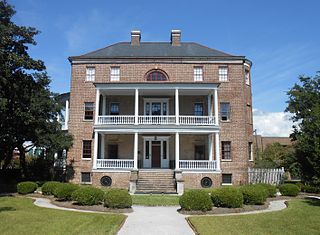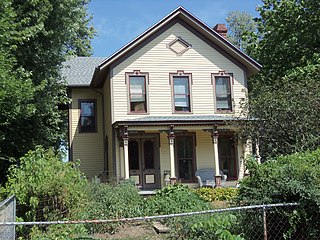
The Benjamin Harrison Presidential Site, previously known as the Benjamin Harrison Home, is the former home of the 23rd president of the United States, Benjamin Harrison. It is in the Old Northside Historic District of Indianapolis, Indiana. Harrison's 16-room house was built from 1874 to 1875. It was from the front porch of the house that Harrison instituted his famous Front Porch Campaign in the 1888 United States presidential campaign, often speaking to crowds on the street. In 1896, Harrison renovated the house and added electricity. He died there in a second-story bedroom in 1901. Today it is owned by the Arthur Jordan Foundation and operated as a museum to the former president by the Benjamin Harrison Foundation.

The Joseph Manigault House is a historic house museum in Charleston, South Carolina that is owned and operated by the Charleston Museum. Built in 1803, it was designed by Gabriel Manigault to be the home of his brother, and is nationally significant as a well-executed and preserved example of Adam style architecture. It was declared a National Historic Landmark in 1973.

The Joseph Temple House is a historic house in Reading, Massachusetts. The Second Empire wood-frame house was built in 1872 by Joseph Temple, owner of locally prominent necktie manufacturer. The house was listed on the National Register of Historic Places in 1984.

The First White House of the Confederacy is a historic house in Montgomery, Alabama, which was the initial executive residence of President of the Confederate States of America Jefferson Davis and family during early 1861. Moved from its original location in 1919 and completely furnished with original period pieces from the 1850s and 1860s, the 1835 Italianate-style house is open to the public. It has been listed on the National Register of Historic Places since 1974 and the Alabama Register of Landmarks and Heritage since 2012.
Lasher-Davis House is a historic home located at Nelliston in Montgomery County, New York. It was built in 1865 and is a small, 1+1⁄2-story frame building with a gable roof. It features an attractive porch with cut-out railings and brackets under the porch eaves.

The Ora Blanchard House is an historic house at the junction of Maine State Routes 16 and 27 in the center of Stratton, Maine, United States. Also known as Widow's Walk, this wood-frame house, built in 1892, is by far the most distinctive house in the small community, exhibiting a creative collection of Queen Anne features in a remote rural area. It was listed on the National Register of Historic Places in 1980.

The House at 919 Oneida Street is a historic building located on the east side of Davenport, Iowa, United States. It has been listed on the National Register of Historic Places since 1984.

The Oscar C. Woods House is a historic building located on the east side of Davenport, Iowa, United States. It has been listed on the National Register of Historic Places since 1984.

The Anthony Burdick House is a historic building located on the eastside of Davenport, Iowa, United States. It has been listed on the National Register of Historic Places since 1984.

The George B. Swan House is a historic building located on the east side of Davenport, Iowa, United States. It has been listed on the National Register of Historic Places since 1983.

The George Stumpf House is a historic residence in Indianapolis, Indiana, United States. Located along Meridian Street on the southern side of the city, it was started in 1870 and completed in 1872.

Oakhurst, also known as Winston Place and Mitchell Place, is a historic house in Emelle, Sumter County, Alabama. The two-story wood-frame house was built for Augustus Anthony Winston, a banker and cotton factor from Mobile, in 1854. The Greek Revival-style structure is five bays wide, with a one-story porch spanning the entire width of the primary facade. A bracketed cornice atop the entablature wraps around the entire house. It reflects the influence of the Italianate-style. This architectural combination, sometimes referred to as a "bracketed Greek Revival" style, was popular in Alabama from the 1850s to 1890s.

Bishop House is a historic home located near Graysontown, Montgomery County, Virginia. The house was built about 1890, and is a one- to two-story, three-bay, brick dwelling with a double pile central passage plan. It has a standing seam metal gable roof. Its front porch features turned posts and a baluster bracketed spindle frieze with drop pendants, and a pointed window in the steep pedimented gable.

Quaker Meadows, also known as the McDowell House at Quaker Meadows, is a historic plantation house located near Morganton, Burke County, North Carolina. It was built about 1812, and is a two-story, four bay by two bay, Quaker plan brick structure in the Federal style. It features two one-story shed porches supported by square pillars ornamented by scroll sawn brackets. The Quaker Meadows plantation was the home of Revolutionary War figure, Col. Charles McDowell. It was at Quaker Meadows that Zebulon Baird Vance married Charles McDowell's niece, Harriet N. Espy.

The house at 1254–1256 Montgomery Street is a historic house located in the Telegraph Hill neighborhood of San Francisco. Construction commenced in the early 1860s [partial first floor] and sits on a secondary summit of the hill, which was also the site of a windmill that burned in 1861. The house's Italianate architecture design features large windows on the front corner, double-hung sash windows decorated with pilasters and cornices, and a bracketed cornice along the roofline. While the house originally had only one story, its second story was part of its original plan and constructed by the 1890s. The house is one of the few buildings on Telegraph Hill which survived the 1906 San Francisco earthquake and its aftermath.

The Dothan station, also known as Atlantic Coastline Railroad Passenger Depot, is a historic train station in Dothan, Alabama. It was built in 1907 as the largest and busiest on the Atlantic Coast Line Railroad between Montgomery, Alabama, and Thomasville, Georgia and replaced a former freight depot. The Atlantic Coast Line merged with the Seaboard Air Line Railroad in 1967 to form the Seaboard Coast Line Railroad. In 1971, Amtrak took over passenger rail service in the United States and Dothan station was served by the Floridian until 1979.

44 Front Street in Burlington, Vermont is a well-preserved vernacular Queen Anne Revival house. Built about 1860 and significantly altered in 1892, it is representative of two periods of the city's growth in the 19th century. It was listed on the National Register of Historic Places in 2008.

The Montgomery House is a historic travel accommodation on Vermont Route 118 in the center of Montgomery, Vermont. Built in 1803, it is one of the town's oldest buildings, and it served for many years as a social and civic center in the small community. It was listed on the National Register of Historic Places in 1992.

The Stay House is a historic residence in Montgomery, Alabama. The house was built in 1893 for physician and politician John Howard Henry. Henry studied medicine in New York and Philadelphia before returning to Montgomery to practice. After his father's death in 1857 he moved to Selma and became active in politics, and was mayor at the end of the Civil War. Henry became active in the Republican Party, but abandoned his political career in the early 1880s, returning to Montgomery and resuming his medical practice.

The Wharton–Chappell House is a historic residence in Montgomery, Alabama. The house was built in 1854 by William G. Wharton, who owned a brick works on an adjacent property. He sold the property in 1859 to Thomas Dorsey, whose widow married James Chappell in 1865. Chappell amassed over 450 acres (180 ha) of farmland on Montgomery's west side, including land surrounding the house. The house remained in the Chappell family until 1928. It was sold to the federal government in 1935, where the Public Works Administration built a housing project named Riverside Heights. The house was converted into offices for the complex, which opened in 1937 and was transferred to the city housing authority in 1939. The complex closed in 2006 and demolished in 2009, with only the house remaining. An artificial whitewater rafting park was opened on the site in 2023.






















